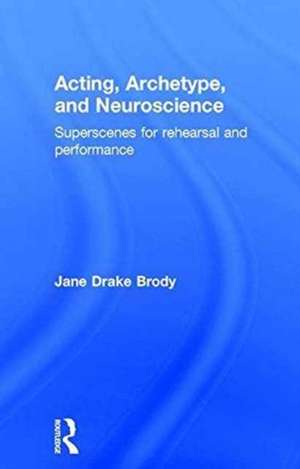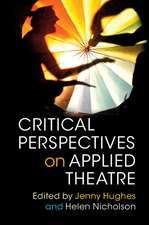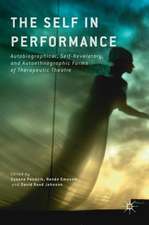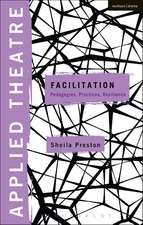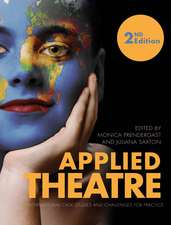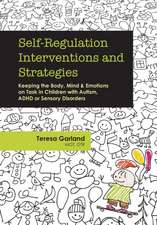Acting, Archetype, and Neuroscience: Superscenes for Rehearsal and Performance
Autor Jane Drake Brodyen Limba Engleză Hardback – 11 oct 2016
Superscenes are a revolutionary new mode of teaching and rehearsal, allowing the actor to discover and utilize the primal energies underlying dramatic texts. In Acting, Archetype, and Neuroscience Jane Drake Brody draws upon a lifetime’s experience in the theatre, alongside the best insights into pedagogical practice in the field, the work of philosophers and writers who have focused on myth and archetype, and the latest insights of neuroscience.
The resulting interdisciplinary, exciting volume works to:
- Mine the essentials of accepted acting theory while finding ways to access more primally-based human behavior in actors
- Restore a focus on storytelling that has been lost in the rush to create complex characters with arresting physical and vocal lives
- Uncover the mythical bones buried within every piece of dramatic writing; the skeletal framework upon which hangs the language and drama of the play itself
- Focus on the actor’s body as the only place where the conflict inherent in drama can be animated.
| Toate formatele și edițiile | Preț | Express |
|---|---|---|
| Paperback (1) | 326.37 lei 6-8 săpt. | |
| Taylor & Francis – 11 oct 2016 | 326.37 lei 6-8 săpt. | |
| Hardback (1) | 995.54 lei 6-8 săpt. | |
| Taylor & Francis – 11 oct 2016 | 995.54 lei 6-8 săpt. |
Preț: 995.54 lei
Preț vechi: 1214.07 lei
-18% Nou
Puncte Express: 1493
Preț estimativ în valută:
190.53€ • 197.40$ • 159.00£
190.53€ • 197.40$ • 159.00£
Carte tipărită la comandă
Livrare economică 21 martie-04 aprilie
Preluare comenzi: 021 569.72.76
Specificații
ISBN-13: 9781138822603
ISBN-10: 1138822604
Pagini: 172
Dimensiuni: 138 x 216 mm
Greutate: 0.32 kg
Ediția:1
Editura: Taylor & Francis
Colecția Routledge
Locul publicării:Oxford, United Kingdom
ISBN-10: 1138822604
Pagini: 172
Dimensiuni: 138 x 216 mm
Greutate: 0.32 kg
Ediția:1
Editura: Taylor & Francis
Colecția Routledge
Locul publicării:Oxford, United Kingdom
Public țintă
General, Postgraduate, Professional Practice & Development, and UndergraduateCuprins
Preface
Introduction
Section One: Origins
Chapter 1: Returning to Mythic Roots
Physical Beginnings of Acting
Current Actor Training
Current Training
Hymn: To Vulcan (Hephaistos), Fumigation from Frankincense and Manna
Chapter 2: Resurrecting Mythic Stories
Linking Neuroscience and Archetypal Mythology
Chapter 3: Primary Conflict and the Hero’s Journey
Primary Conflict: Order Versus Chaos
Peter and Wendy
Section Two: The Exercises and the Work
Chapter 4: The Exercises
Meditation
Magnets
Push, Pull, Hold, Release
Sticks
Viewpoints
Second Viewpoints Class: Contact and Company
Day Three: Company, Architecture, and Music
Chapter 5: Beginning Superscenes
Text and Archetypes
Fourth Session: Exercise: Using the Monomyth
A Linear Representation of the Hero’s Journey
Inciting Incident: Exact Scene? Exact Line? Exact Rationale?
Chapter 6: Two Hero’s Journeys
The Hero’s Journey of Muhammad Ali
Hamlet’s Journey: A Brief and Debatable Look at Hamlet as Hero
Chapter 7: Bridging and Superscenes
Bridges
Superscenes
Superscenes and Memory
Section Three: Neuroscience and Images
Chapter 8: Mirror Neurons, Emotions, Memory, Meditation, Embodiment, and Images
The Limbic System
The Eternally Balancing Body
Meditation
Phenomenology: The Study of the Experience of Intention
Mirror Neurons
Second Person Interactivity: MNs
The Use of Metaphor, Image, and Active Words
Memory: Images and the Brain
Memory, Archetype, and Mirror Neurons
Memory Consolidation
Chapter 9: Archetypal Patterns
Family Stories
CG Jung
Archetypal Patterns of Plots
Chapter 10: Archetypal Journey; In The Blood by Susan Lori Parks
The Ancient Story, Myth and Archetype
Protagonist/Antagonist Statement
Hester’s Hero’s Journey
Chapter 11: Conclusion
Bibliography
Index
Introduction
Section One: Origins
Chapter 1: Returning to Mythic Roots
Physical Beginnings of Acting
Current Actor Training
Current Training
Hymn: To Vulcan (Hephaistos), Fumigation from Frankincense and Manna
Chapter 2: Resurrecting Mythic Stories
Linking Neuroscience and Archetypal Mythology
Chapter 3: Primary Conflict and the Hero’s Journey
Primary Conflict: Order Versus Chaos
Peter and Wendy
Section Two: The Exercises and the Work
Chapter 4: The Exercises
Meditation
Magnets
Push, Pull, Hold, Release
Sticks
Viewpoints
Second Viewpoints Class: Contact and Company
Day Three: Company, Architecture, and Music
Chapter 5: Beginning Superscenes
Text and Archetypes
Fourth Session: Exercise: Using the Monomyth
A Linear Representation of the Hero’s Journey
Inciting Incident: Exact Scene? Exact Line? Exact Rationale?
Chapter 6: Two Hero’s Journeys
The Hero’s Journey of Muhammad Ali
Hamlet’s Journey: A Brief and Debatable Look at Hamlet as Hero
Chapter 7: Bridging and Superscenes
Bridges
Superscenes
Superscenes and Memory
Section Three: Neuroscience and Images
Chapter 8: Mirror Neurons, Emotions, Memory, Meditation, Embodiment, and Images
The Limbic System
The Eternally Balancing Body
Meditation
Phenomenology: The Study of the Experience of Intention
Mirror Neurons
Second Person Interactivity: MNs
The Use of Metaphor, Image, and Active Words
Memory: Images and the Brain
Memory, Archetype, and Mirror Neurons
Memory Consolidation
Chapter 9: Archetypal Patterns
Family Stories
CG Jung
Archetypal Patterns of Plots
Chapter 10: Archetypal Journey; In The Blood by Susan Lori Parks
The Ancient Story, Myth and Archetype
Protagonist/Antagonist Statement
Hester’s Hero’s Journey
Chapter 11: Conclusion
Bibliography
Index
Notă biografică
Jane Drake Brody teaches graduate and undergraduate Acting at The Theatre School at DePaul University, following a long career as an actress, director, professional acting coach and casting director. Her many film and TV casting credits include the Oscar winning Fargo, for which she received the Casting Society of America's Best Location Casting Award.
Descriere
Acting, Archetype, and Neuroscience weaves together a wealth of seemingly disparate performance methods, exciting actors to imaginatively and playfully take risks they might otherwise avoid. A radical new mixture of theory and practice by Jane Drake Brody, a highly respected teacher of acting, this volume is a must-read for students and performance practitioners alike.
